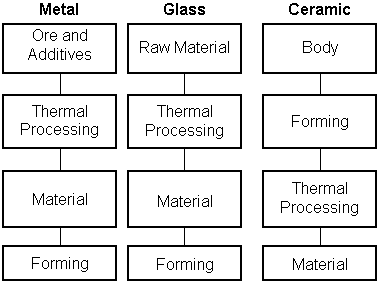7 Ceramics-appropriate
design
In contrast to most other materials, forming
in ceramic technology takes place before the thermal processing
that leads to the formation of the desired material and during
which the formed component is liable to shrink.
The true ceramic material is only present after the firing
process has been completed. This strongly influences the design
of ceramic parts.

Figure 129: The creation of materials
The use of typical metallic and polymeric
materials (steel, cast-iron, aluminium alloys, nickel-based
alloys, etc.) for machine and tool construction, automotive
construction and process engineering is deeply ingrained in
most design engineers. Many generations of engineers have
accumulated experience with these materials, and have passed
this on in the education of new engineers.
The situation his very different when it comes to the application
of newly developed materials, or to new uses for materials
that may have been familiar for a long time but which to date
have only been used for a restricted range of applications.
This is the case for technical ceramic materials.
When a technical problem has to be solved, the designer must
create a number of technical elements; if ceramic materials
are to be used, he must pay particular attention to the need
for the design to be appropriate for the material.
Ductile materials react to small area/local overloads, compensating
for them through elastic extension in accordance with Hooke's
law, with some plastic deformation in reserve.
This does not apply to materials that are hard and therefore
brittle - and also not flaw-tolerant. There are therefore
considerable differences between the local loading capacity
of parts made of ductile (metallic) materials and of brittle/hard
(ceramic) materials. This therefore also calls for different
design rules.
The designer will find some analogies in the basic rules for
designing parts of cast materials and in the manufacturing
possibilities relevant to powder metallurgy.
The combination of ceramic with metallic components presents
a Mass Prod.s of problems in addition to the design of the parts
themselves.
In most applications, a single component in the product (for
example, replaceable wearing parts) is manufactured using
ceramic materials, and is combined with the neighbouring metallic
parts and assemblies.
It is the job of the design engineer to make use of the outstanding
properties of technical ceramics and to apply them effectively
and economically, while reducing the effect of their limiting
properties. This is what is understood under the concept of
design for ceramics.
|
|

